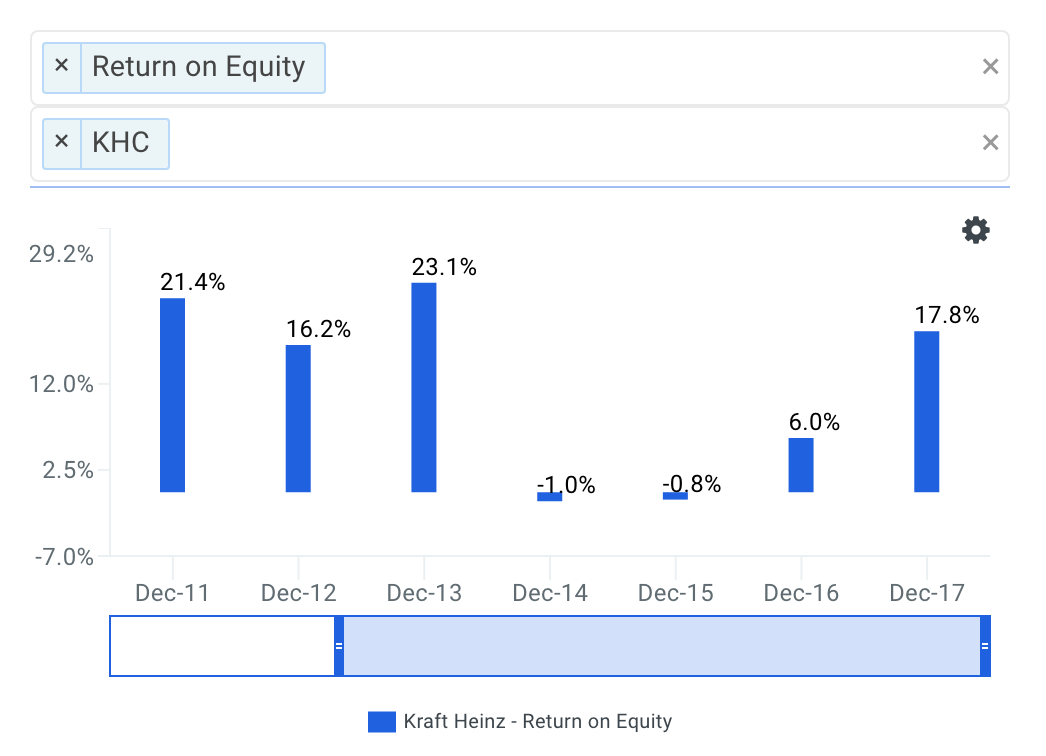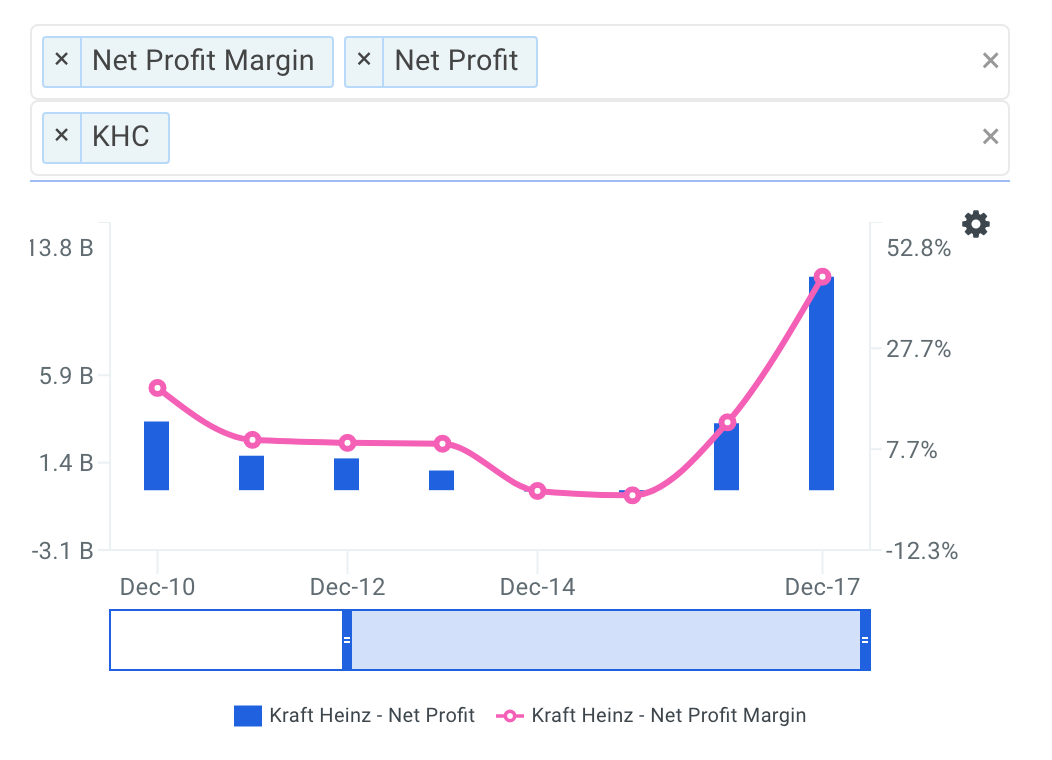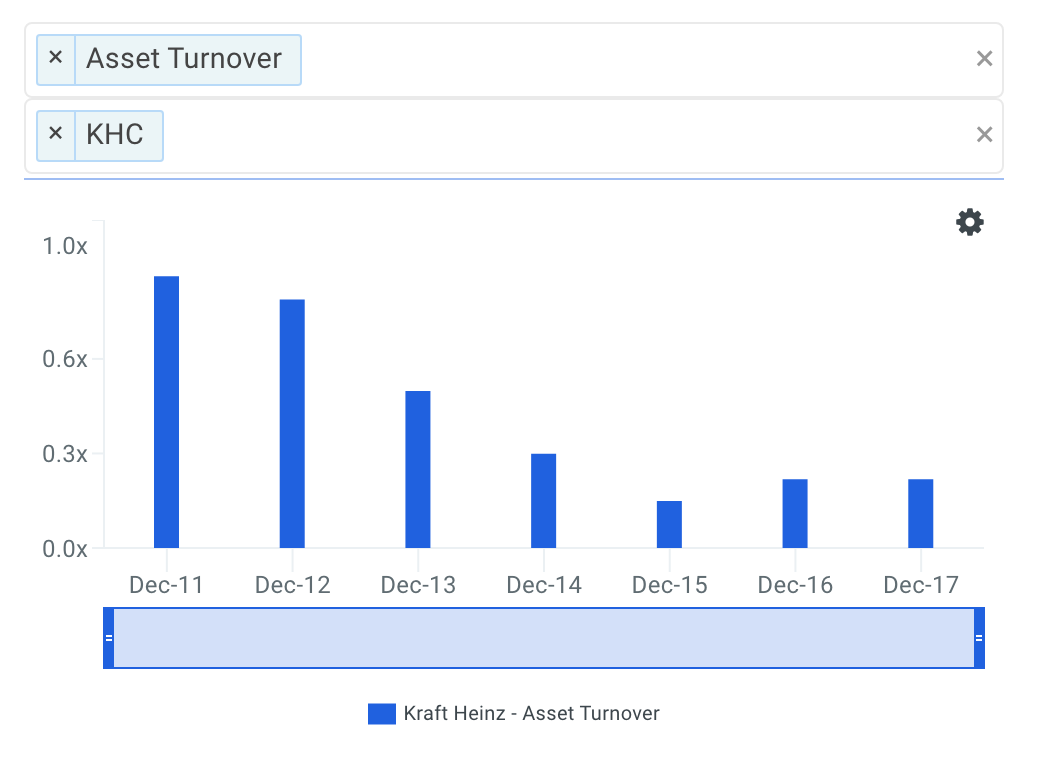Kraft Heinz Co (NASDAQ: KHC) beat the Consumer Staples sector by 6.4% as it relates to ROE, producing a healthy 17.8% compared to the sector's 11.3%. But what is more interesting is whether Kraft will continue to achieve above average returns moving forward. The DuPont analysis is a useful tool that may help us determine this. In my analysis below, I'll use the DuPont model to reveal what's really driving the company's healthy ROE.
Kraft's ROE Trends
Return on equity or ROE represents the percentage return a company generates on the money shareholders have invested.
ROE = Net Income To Common / Average Total Common Equity
In general, a higher return on equity suggests management is utilizing the capital invested by shareholders efficiently. However, it is important to note that ROE can be impacted by management's financing decisions such as the deployment of leverage.
Kraft's recent ROE trends are illustrated in the chart below.

source: finbox.io data explorer - ROE
It appears that the return on equity of Kraft has generally been increasing over the last few years. ROE increased from -0.8% to 6.0% in fiscal year 2016 and increased to 17.8% in 2017. So what's causing the general improvement?
What's Causing Kraft's Improving Return On Equity
A less used approach although being much more intuitive, the DuPont formula is another way to calculate a company's ROE. It is defined as:
ROE = Net Profit Margin * Asset Turnover * Equity Multiplier
Created by the DuPont Corporation in the 1920s, the analysis is a useful tool that helps determine what's responsible for changes in a company's ROE. It highlights that a firm's ROE is affected by three things: profit margin, asset turnover, and its equity multiplier or financial leverage.
Analyzing changes in these three items over time allows investors to figure out if operating efficiency, asset use efficiency or the use of leverage is what's causing changes in ROE. Strong companies should have ROE that is increasing because its net profit margin and/or asset turnover is increasing. On the other hand, a company may not be as strong as investors would otherwise think if ROE is increasing from the use of leverage or debt.
So let's take a closer look at what's causing Kraft's improving returns.
Kraft's Net Profit Margin Trends
It appears that the net profit margin of Kraft has generally been increasing over the last few years. Margins increased from -1.5% to 13.0% in fiscal year 2016 and increased to 41.9% in 2017.

source: data explorer - net profit margin
Therefore, the company's increasing margins help explain, at least partially, why ROE is also increasing. Now let's take a look at Kraft's efficiency performance to see if that is also boosting ROE.
Kraft's Asset Turnover Trends
It appears that asset turnover of Kraft has generally been declining over the last few years. Turnover decreased from 0.23x to 0.22x in fiscal year 2016 and stayed at 0.22x in 2017.

source: data explorer - asset turnover
Therefore, the company's ROE improvement is not as a result of its asset turnover performance which has generally been decreasing.
Finally, the DuPont constituents that make up Kraft's ROE are shown in the table below. Note that the table also compares Kraft to a peer group that includes Campbell Soup Company (NYSE: CPB), General Mills, Inc. (NYSE: GIS), Kellogg Company (NYSE: K) and McCormick & Company, Incorporated (NYSE: MKC.V).

source: finbox.io's DuPont model
In conclusion, the DuPont analysis has helped us better understand that Kraft's general improvement in return on equity is the result of a significant improvemetn in net profit margin. Therefore when looking at the core operations of the business, Kraft shareholders have reason to be excited.
The DuPont approach is a helpful tool when analyzing how well management is utilizing shareholder capital. However, it doesn't necessarily tell the whole story. For example, how do the company's ROE trends compare to its peers or sector? How about in absolute returns? I recommend that investors continue to research Kraft to gain a better understanding of its fundamentals before making an investment decision.
Author: Brian Dentino
Expertise: financial technology, analyzing market trends
Brian is a founder at finbox.io, where he's focused on building tools that make it faster and easier for investors to research stock fundamentals. Brian's background is in physics & computer science and previously worked as a software engineer at GE Healthcare. He enjoys applying his expertise in technology to help find market trends that impact investors.
Brian can be reached at [email protected].
As of this writing, Brian did not hold a position in any of the aforementioned securities and this is not a buy or sell recommendation on any security mentioned.


